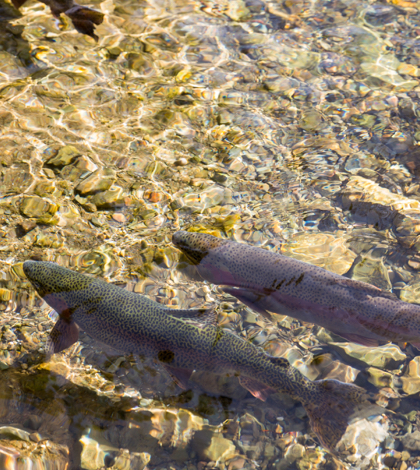Twenty years of restoration efforts on Butte Creek have paid off. Following the drought of the late 1980s spring-run salmon had dwindled to less than 100 returning adults in some years in Butte Creek. As one of only four Sacramento River tributaries with remaining populations of spring-run Chinook salmon, Butte Creek’s resource agencies and environmental groups value the creek’s role preserving the spring-run salmon and they knew they needed to take action.
“When I was here twenty years ago, there was spirit of hope for California to find a better balance between agriculture, recreation and the environment,” said Bruce Babbitt, former US Secretary of the Interior. “And today, we celebrate that hope being reality on Butte Creek. Butte Creek is a wonderful example of how innovation and partnerships can lead to real improvements for fish, and there are many lessons we can take from Butte Creek as we address other water challenges in California.”
Babbitt and partners from state and federal agencies, conservation organizations, water districts, and area farmers recently celebrated the 20th anniversary of restoration efforts on Butte Creek that have led to a significant recovery of the spring-run Chinook salmon. Now, more than 10,000 spring-run salmon, on average, return to Butte Creek as a result of the Butte Creek Fish Passage Improvement projects, in tandem with a valuable food supply and a safe rearing habitat in the Sutter Bypass wetlands.
In addition to restoring the creek for the benefit of spring-run salmon, these projects also effectively divert water for the benefit of farms, birds and other species along the Pacific Flyway. The Butte Creek Fish Passage Improvement projects are located along 90 miles of the middle reach of Butte Creek, comprising one of the nation’s most significant fisheries restoration efforts.
“The Butte Creek effort is a leading example of how regional leaders are working to re-establish the natural connection between water and the landscape, providing functional and targeted flows that are directly tailored to benefit salmon and other species,” said Ted Trimble, general manager, Western Canal Water District. “And the results of these efforts are real, they are making a difference.”
The reasons for the success of the restoration of Butte Creek and the prolific return of the spring-run salmon include water management in the upper reach of Butte Creek that provides well-timed functional flows for spawning and holding habitat as well as the Butte Creek fish passage improvement projects along the middle reach of the creek, including the Gorrill Ranch diversion and the Western Canal Gary Brown siphon. The fish food production and safe rearing habitats for juvenile fish in the lower reaches of the creek, flowing through the wetlands created by the Sutter Bypass, have also contributed to the successful return of the spring-run salmon.
Partnerships developed during this project were essential to its success. Key stakeholders included the California Department of Fish and Game, California Urban Water Agencies, U.S. Department of Interior and agricultural, urban, and environmental communities.
“The Butte Creek restoration projects happened because of the cooperation between the different communities involved. We are pleased to see these partnerships continue to bring new, innovative projects to the Sacramento Valley to benefit salmon and other species,” said Jeff Kightlinger, general manager, Metropolitan Water District of Southern California. MWD has invested in numerous salmon projects in Northern California, including providing funding that helped with the Western Canal siphon.
 California Water News Daily Your Source For Water News in California
California Water News Daily Your Source For Water News in California


